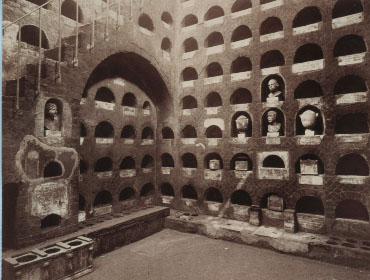|
|
 |
|
Freedmen Tombs of Pompeii |
|
written
by julia625 / 10.12.2005 |
|
|
|
Roman Death and Burial |
| |
Describe |
| |
| |

|
| http://www.umich.edu/~kelseydb/Exhibits/
Death_on_Display/Cremation_Group/funeral.html |
| Artifacts found in Ancient Roman Tombs |
| Here is a small collection of artifacts that may be found in a tomb in ancient Rome. They include a stone with a funeary inscription, fragments of bone, pots and glass vials that may have contained oils or perfumes. |
| |
|
| |

|
| http://www.umich.edu/~kelseydb/Exhibits/
Death_on_Display/Cremation_Group/columbarium.html |
| Ancient Roman Columbarium |
| This is a photograph of an ancient Roman Columbarium. This was a large, usually underground, vault where the creamated remains of Roman citizens would often be stored. As you can see, each person (or sometimes family) had their own niche marked by a bust or plaque. |
| |
|
The ancient Roman view of the afterlife was strongly tied to their burial practices. Romans believed that the soul of the dead was only truly laid to rest once the body had been properly buried. Burial was taken very seriously and the necessary ceremonies could take up to a week. Tending to the dead was very important and ritualistic. To prepare the body, the relatives would traditionally close the deceased's eyes while calling out the name of their dead as though they were calling him back to life. Then the body was washed and limbs straightened, and laid near the front door of the house for a few days so that friends and neighbors could come pay their respects. A coin was then traditionally placed in the mouth of the deceased. The coin was payment to Charon, who ferried the dead across the rivers of the underworld. The act of burying the dead with a coin was not standard, however it was common and many tombs have been found with a coin alongside the body. Once the body was prepared, the funeral procession would commence. This process varied greatly with status. A poor man would simply be carried to his tomb by his friends and family while a wealthy, influential member of society would warrant a more elaborate event. His procession would typically include a band of musicians leading up the procession, followed by jesters and men wearing wax masks of the deceased, then the visible body of the deceased carried on some sort of couch, and finally the family and libertini, then friends. It is important to note here that the freed slaves of the family came before their friends. This further shows the extent of the relationship that was maintained between freed slave and ex master.
If the deceased was middle or low class, the funeral procession would proceed straight to the burial site but, once again, if the deceased was wealthy, the funeral procession would be extended. Depending on the status of the departed, the procession could possibly even honored by public authority with a funereal oration in the forum. Only after the body of the wealthy had been sufficiently paraded around the city would it resume its course to the cemetery. Once the body reached the burial site, it would be placed in its grave. The actual burying of the body varied with time, and different customs were more typical to different time periods. Both cremation and inhumation were practiced throughout Roman history. There are, however, some generalizations that can be made. If the body was to be cremated, a shallow grave would be filled with dry wood and the body would be laid on top of it then set to fire. Once all had burned, the grave would either be covered with earth or the ashes taken to a separate site for burial. If the body was to be buried, it would be covered and laid in its tomb. Regardless of status, the dead were laid to rest with tokens and gifts to ensure that they did not return and bring unhappiness and despair to their family. The extravagance of the gifts and tomb, however, depended on the wealth of the deceased. After burial, the family would traditionally partake in nine days of sorrow before moving on with life.
The actual tombs, especially for the wealthy, often lined public streets leading away from the city. The dead were not allowed to be buried, or even cremated, within the city walls due to sanitation; possibly to prevent the spread of disease. Although eventually cemeteries were set aside for burial, these tombs along side the road remained popular until land began to become scare. Before lack of land was a problem, however, as long as they were outside the city walls, there was no regulation on where, or how big, tombs could be. Wealthy families often had huge, elaborate plots lining the road as close to the entry of the city as possible. The smaller tombs of the less wealthy were jammed in between them wherever there was room. One tomb could contain one body, or the bodies of an entire family. Tombs were designed to have a lavish front displaying the wealth of its inhabitant to any passerby. The body was generally enclosed in a sepulcher chamber within. The fronts of the tombs were often characterized by funerary reliefs. These are carvings on the front of the tombs decorated with significant objects such as portraits, possibly even an inscription, and items that otherwise portrayed the wealth and lifestyle of the departed. The actual shape of the tombs depended on personal preference. More tombs around 200 AD were house shaped while earlier tombs took more extravagant geometrical shapes. Only the very lowest class was buried in mass graves with total strangers.
|
| |
|
| |
|
|
 |
|


